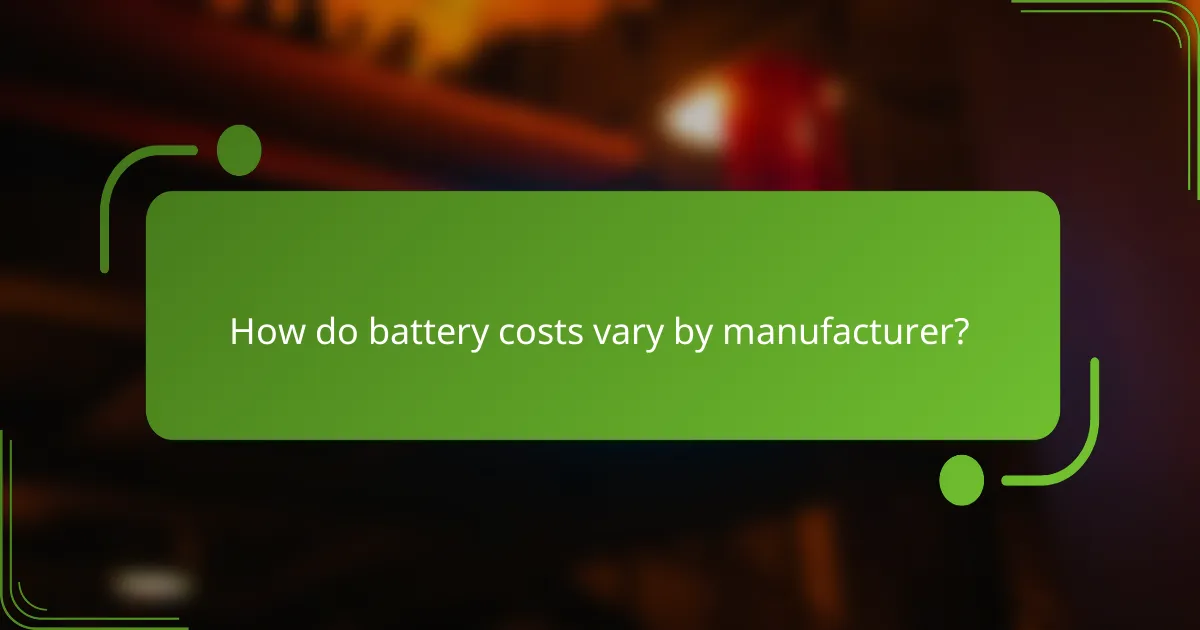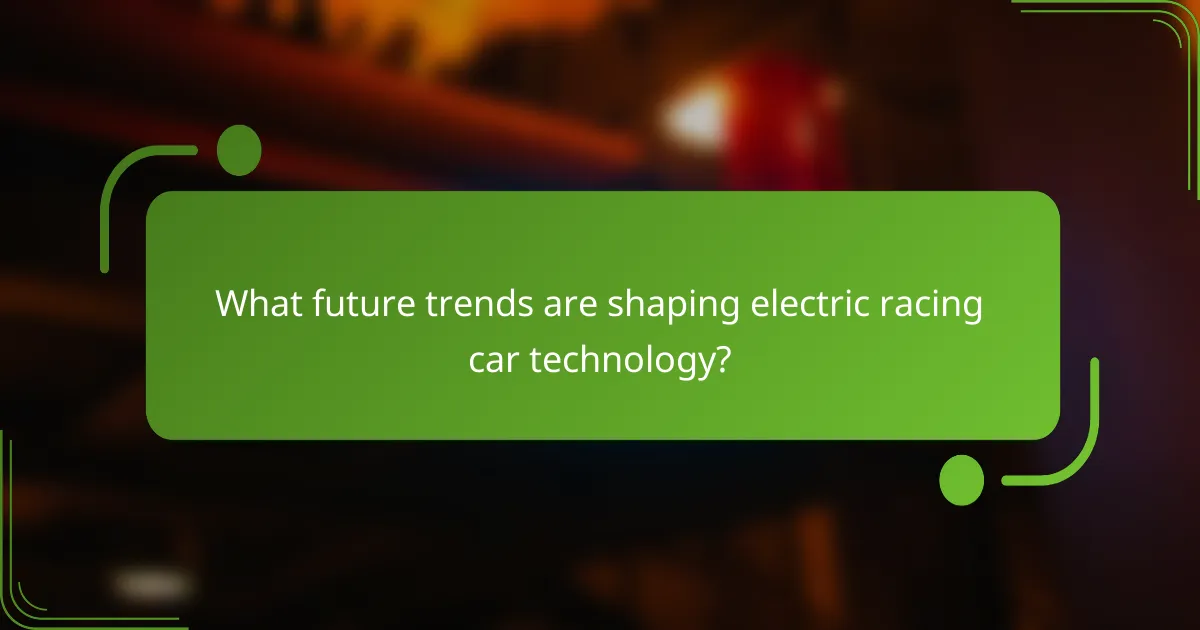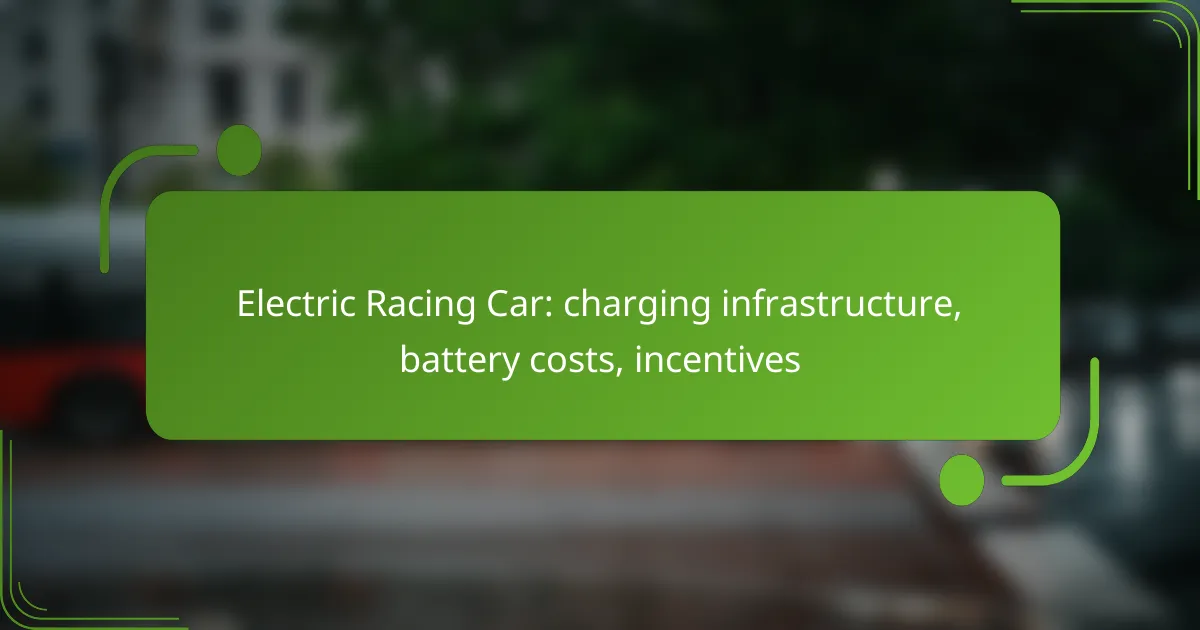Electric racing cars are gaining traction in Canada, supported by a robust charging infrastructure that includes Level 2 stations and DC fast charging networks. As battery costs continue to decline, these vehicles become more accessible and appealing to racing enthusiasts. Additionally, buyers can take advantage of various financial incentives, such as federal tax credits and provincial rebates, further enhancing the attractiveness of electric racing cars.

What are the charging infrastructure options for electric racing cars in Canada?
In Canada, electric racing cars can utilize various charging infrastructure options, including Level 2 charging stations, DC fast charging networks, and home charging solutions. Each option offers different charging speeds and accessibility, catering to the unique needs of racing enthusiasts.
Level 2 charging stations
Level 2 charging stations provide a moderate charging speed, typically delivering around 10 to 20 kilowatts. This means they can fully charge an electric racing car in approximately 4 to 8 hours, making them suitable for overnight charging at home or during events.
These stations are commonly found in public areas, such as shopping centers and parking lots, and often require a subscription or payment per use. It’s essential to check the availability of Level 2 stations in your area, especially when planning for race events.
DC fast charging networks
DC fast charging networks are designed for rapid charging, offering power levels from 50 kilowatts to over 350 kilowatts. This allows electric racing cars to charge up to 80% in as little as 30 minutes, making them ideal for quick pit stops during races.
In Canada, major networks like Electrify Canada and ChargePoint are expanding their DC fast charging stations across provinces. Ensure your racing car is compatible with the charging standards used by these networks to maximize efficiency.
Home charging solutions
Home charging solutions typically involve installing a Level 2 charger in your garage, allowing for convenient overnight charging. This setup can significantly reduce downtime and ensure your electric racing car is always ready for the next event.
When considering home charging, evaluate the electrical capacity of your home and consult with a professional to ensure proper installation. Incentives may be available in some provinces to offset installation costs, making home charging a more affordable option.

How much do battery costs impact electric racing car ownership?
Battery costs significantly influence the overall expense of owning an electric racing car, impacting both initial purchase prices and long-term operational costs. As battery prices decrease, the affordability and accessibility of electric racing cars improve, making them more appealing to enthusiasts and competitors alike.
Average battery prices in 2023
In 2023, the average price of electric vehicle batteries has been reported to range between $100 to $150 per kilowatt-hour (kWh). This reduction in costs compared to previous years has been driven by advancements in technology and increased production efficiency. For racing applications, where performance is crucial, higher-end batteries may still command premium prices.
For instance, a typical electric racing car may require a battery capacity of around 50 to 100 kWh, leading to total battery costs ranging from $5,000 to $15,000. This investment is a key consideration for teams and individuals looking to enter the electric racing scene.
Cost comparison of different battery technologies
Different battery technologies offer varying performance characteristics and costs. Lithium-ion batteries are the most common choice, providing a good balance of energy density, weight, and cost. However, alternatives like solid-state batteries, while potentially offering higher energy densities and safety, are still in the developmental phase and can be significantly more expensive.
For example, while lithium-ion batteries might cost around $100 to $150 per kWh, solid-state batteries could exceed $300 per kWh. This price difference can heavily influence the decision-making process for racing teams, as they weigh performance benefits against budget constraints.
Ultimately, the choice of battery technology will depend on the specific requirements of the racing event, such as weight limits, power output, and the desired range, making it essential to assess both performance and cost when selecting a battery for electric racing cars.

What incentives are available for electric racing car buyers in Canada?
Electric racing car buyers in Canada can benefit from various financial incentives, including federal tax credits and provincial rebates. These programs aim to encourage the adoption of electric vehicles by reducing the overall cost of purchase and ownership.
Federal tax credits
The Canadian federal government offers tax credits for electric vehicle purchases, which can significantly lower the upfront cost. As of now, buyers can receive up to CAD 5,000 in tax credits, depending on the vehicle’s battery capacity and price.
To qualify for these credits, the electric racing car must meet specific criteria set by the government, such as being fully electric and having a minimum battery size. It’s essential to check the latest guidelines to ensure eligibility.
Provincial rebates
In addition to federal incentives, several provinces in Canada provide their own rebates for electric racing car buyers. For example, British Columbia offers rebates up to CAD 3,000, while Quebec has a program that can provide up to CAD 8,000.
Each province has different eligibility requirements and application processes, so it’s crucial to research the specific rebates available in your province. Combining federal and provincial incentives can lead to substantial savings on your electric racing car purchase.

What are the key considerations for selecting charging infrastructure?
When selecting charging infrastructure for electric racing cars, key considerations include charging speed requirements and location accessibility. These factors directly impact the efficiency and convenience of charging during races or practice sessions.
Charging speed requirements
Charging speed is crucial for minimizing downtime during races. Fast chargers can deliver power at rates ranging from 50 kW to over 350 kW, significantly reducing the time needed to recharge batteries. For racing applications, look for chargers that can provide a full charge in under an hour, ideally within 20-30 minutes.
Consider the compatibility of the charging infrastructure with your vehicle’s battery management system. Ensure that the chargers meet industry standards such as CCS (Combined Charging System) or CHAdeMO, which are widely used in electric vehicles. This compatibility ensures efficient energy transfer and safety during charging.
Location accessibility
Accessibility of charging stations is vital for effective race planning. Identify locations where charging infrastructure is available near race tracks or practice facilities. Ideally, these stations should be strategically placed to allow quick access during pit stops or breaks.
Evaluate the availability of charging stations in the regions where you plan to race. Consider factors such as proximity to major highways, ease of entry and exit, and the presence of amenities like restrooms and food services. This will enhance the overall experience for the team and drivers during events.

How do battery costs vary by manufacturer?
Battery costs can significantly differ by manufacturer due to factors like production scale, technology, and supply chain efficiencies. Generally, larger manufacturers with established supply chains tend to offer lower prices, while newer or niche companies may have higher costs.
Tesla battery pricing
Tesla is known for its competitive battery pricing, primarily due to its vertical integration and large-scale production. The cost of Tesla batteries typically ranges from around $100 to $150 per kilowatt-hour (kWh), making them one of the more affordable options in the electric vehicle market.
Additionally, Tesla’s ongoing investment in battery technology, including innovations in battery chemistry and manufacturing processes, helps keep costs down. Their Gigafactories are designed to produce batteries at scale, further reducing expenses.
Porsche battery pricing
Porsche, on the other hand, tends to have higher battery costs, reflecting its focus on performance and luxury. The pricing for Porsche batteries can range from $150 to $200 per kWh, influenced by the advanced technology and materials used in their high-performance electric vehicles.
While Porsche batteries may be more expensive, they offer superior performance characteristics, such as faster charging times and enhanced energy density. This premium pricing aligns with Porsche’s brand positioning in the market as a luxury sports car manufacturer.

What are the environmental benefits of electric racing cars?
Electric racing cars offer significant environmental benefits, primarily through reduced carbon emissions and lower noise pollution. These advantages contribute to a more sustainable motorsport industry and promote cleaner technologies.
Reduction in carbon emissions
Electric racing cars produce zero tailpipe emissions, which significantly reduces their carbon footprint compared to traditional gasoline-powered vehicles. This shift is crucial as motorsport events often attract large crowds, leading to substantial overall emissions from both vehicles and spectators.
Furthermore, the environmental impact can be minimized by utilizing renewable energy sources for charging the electric cars. For instance, charging stations powered by solar or wind energy can further decrease the carbon emissions associated with racing events.
Lower noise pollution
Electric racing cars operate much more quietly than their combustion engine counterparts, resulting in lower noise pollution at racetracks. This reduction in noise can enhance the spectator experience and minimize disturbances to nearby communities.
The quieter operation of electric vehicles also allows for more flexible scheduling of races, as noise restrictions may be less of a concern. This can lead to increased opportunities for events in urban areas, promoting greater accessibility to motorsport for fans and participants alike.

What future trends are shaping electric racing car technology?
Future trends in electric racing car technology are primarily driven by advancements in battery technology and the expansion of charging infrastructure. These developments are crucial for enhancing performance, reducing costs, and making electric racing more accessible.
Advancements in battery technology
Battery technology is evolving rapidly, focusing on increasing energy density and reducing charging times. New chemistries, such as solid-state batteries, promise higher capacities and improved safety compared to traditional lithium-ion batteries.
For racing applications, lightweight and high-performance batteries are essential. Current advancements aim for energy densities exceeding 300 Wh/kg, which can significantly enhance vehicle range and speed. Manufacturers are also exploring fast-charging capabilities that can replenish batteries in under 30 minutes.
Expansion of charging networks
The growth of charging networks is vital for supporting electric racing cars, especially in competitive environments. More charging stations are being installed at racetracks and along major routes, making it easier for teams to recharge between races.
In many regions, governments and private companies are investing in ultra-fast charging stations that can deliver high power levels, enabling quick turnaround times. For instance, charging stations capable of delivering 350 kW can charge a racing car in approximately 15-20 minutes, facilitating smoother race operations.
